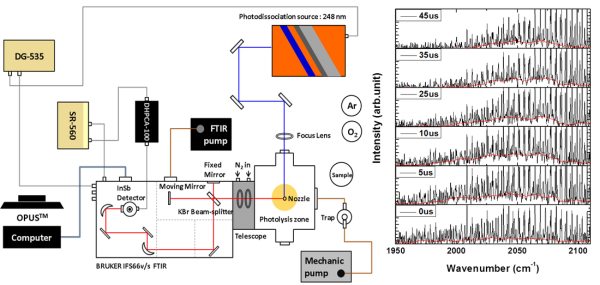
Time-Resolved FT-IR

Other than the ester family, aliphatic aldehyde is a second molecular series that we are looking into this newly found pathway. Aliphatic aldehydes are known to be present in the atmosphere through automobile exhaust or photooxidation of organic compounds. Investigating their photodissociation mechanisms has been a main theme in photochemistry. Among these aldehydes, formaldehyde and acetaldehyde were the only two that have been found to carry roaming signature in the photodissociation. Like the tight transition state (TS) mechanism, there exists a first-order saddle point for the roaming process, showing one small imaginary (harmonic) frequency along with some small frequency modes. Propionaldehyde , as a member of aliphatic aldehydes, shows similar chemical properties to its smaller counterparts, but its photochemistry is much less investigated.
In the past years, we employed time-resolved Fourier-transform infrared (FTIR) emission spectroscopy to probe the HCO and CO fragments in propionaldehyde at 248 nm. Finally, the theoretical methods are performed in conjunction with the experimental findings to clarify dynamical complexity in photodissociation of propionaldehyde. We have found that the roaming pathway dominates the molecular products of CO + C2H6. This work implies that roaming mechanism plays an increasingly important role in aliphatic aldehydes, as the molecular size becomes larger. The results are published in J. Phys. Chem. Lett. 5, 190 (2014) and J. Chem. Phys. 140, 064313 (2014)
